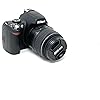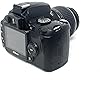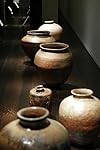Nikon D40 6.1MP Digital SLR Camera Kit with 18-55mm f/3.5-5.6G ED II Auto Focus-S DX Zoom-Nikkor Lens






Buy Now, Pay Later
- – 6-month term
- – No impact on credit
- – Instant approval decision
- – Secure and straightforward checkout
Ready to go? Add this product to your cart and select a plan during checkout.
Payment plans are offered through our trusted finance partners Klarna, Affirm, Afterpay, Apple Pay, and PayTomorrow. No-credit-needed leasing options through Acima may also be available at checkout.
Learn more about financing & leasing here.
This item is eligible for return within 30 days of receipt
To qualify for a full refund, items must be returned in their original, unused condition. If an item is returned in a used, damaged, or materially different state, you may be granted a partial refund.
To initiate a return, please visit our Returns Center.
View our full returns policy here.
Recently Viewed
Features
- 6.1-megapixel CCD captures enough detail for photo-quality 14 x 19-inch prints
- Kit includes 3x 18-55mm f3.5-5.6G ED II AF-S DX Zoom-Nikkor lens
- 2.5-inch LCD with three display options; built-in flash and hot shoe
- Fast startup with instant shutter response; shoot at up to 2.5 frames per second
- Powered by one rechargeable Li-ion battery EN-EL9 (included); stores images on SD memory cards (memory card not included)
Description
From the Manufacturer Manufacturer Description Great pictures used to require complicated and cumbersome equipment along with years of experience. Not any more. The D40 is compact, lightweight and designed specifically for ease of use, yet contains all the top-quality, high-performance technologies that you expect from a Nikon digital SLR. And with world-famous Nikkor lenses, you know you have the sharpest and most reliable optical performance available. All in a camera light enough to carry with you everywhere. Beautiful photography has never been easier. Nikon D40 Highlights Extraordinary Nikon image quality The D40's high-resolution image quality is made possible by Nikon's high- performance 6.1 megapixel Nikon DX format CCD imaging sensor and exclusive Nikon image processing engine which assures stunning sharpness and color. Easy operation with intuitive controls Intuitive controls make the D40 point-and- shoot simple, enabling even first-time SLR users to capture beautiful memories perfectly. Nikon's smallest digital SLR ever At just over 16 ounces, the beautifully styled and compact D40 makes high-performance digital SLR photography easier and more convenient than ever. Fast startup with instant shutter response: Fast startup combined with super-fast shutter response and rapid-action shooting at up to 2.5 frames per second makes it easy to freeze special moments instantly. Includes 3x 18-55mm f/3.5-5.6G ED II AF-S DX Zoom- Nikkor lens Designed exclusively for use with Nikon DX-format digital SLRs, this ultra-compact 3x zoom offers Nikkor sharpness and versatility in a wide variety of shooting situations. Shoot at up to 2.5 frames per second The D40 can fire continuously at a speed of up to 2.5 frames per second, capturing high-quality action sequences of children in sporting activities such as soccer, baseball and much more. 2.5-inch color LCD monitor with 3 colorful display options Playback images are easy to see, and function menus are easier to use with a larger and brighter color LCD monitor. The large 2.5-inch LCD monitor enables image preview at up to 19 times magnification and has large type fonts and easy-to-view menus as well as three all-new display options: Classic, Graphic and Wallpaper. High-performance 6.1-megapixel Nikon DX format CCD imaging sensor Nikon's DX format CCD image sensor delivers vivid color and sharp detail, great for making beautifully detailed enlargements of 16 x 20 inches and beyond. High resolution also provides room for creative cropping. In-camera image editing Highly versatile in-camera editing features include Nikon D-Lighting, Red-Eye Correction, Image Trimming, Image Overlay, Monochrome (Black and White, Sepia and Cyanotype) along with Skylight, Warm Tone and Color Balance filter effects. These features provide greater creative freedom without the need for a computer, for those who prefer to send pictures directly to a printer. New advanced HELP menu system with Assist Images The D40's newly introduced "assist images" help you select the appropriate settings for many camera features by showing an example image typical of that setting as well as an advanced HELP Menu for the current item selected. The D40's Question Mark icon (?) indicates that help is available for the currently selected item; just press the help button beside the LCD monitor to see a context sensitive help page. Fast, accurate 3-area Autofocus The D40's advanced 3-area AF system and the refined algorithms inherited from more advanced Nikon digital SLR cameras deliver fast, efficient and precise autofocus. AF refinements deliver greater precision with fast, more consistent subject acquisition and improved focus tracking for consistently sharper pictures. Image Optimization Options The D40's Image Optimize setting lets photographers adjust color, contrast and sharpening as well as other image settings according to the type of scene or output desired. Settings include: Normal, Softer, Vivid, More Vivid, Portrait, Custom and Black and White, each of which are automatically adjusted based on sophisticated Nikon algorithms or user-selected settings for optimum results. Built-in Speedlight with i-TTL automatic flash control Nikon's innovative i-TTL flash control evaluates flash exposure with incredible precision to achieve better automatic flash balance and deliver outstanding results. The built-in Speedlight is always at the ready and brings beautiful exposures in darkened conditions as well as adding sparkle for fill flash in outdoor situations for enhanced twilight shots or an added impact to daylight images. Bright, accurate SLR viewfinder A large viewfinder makes composition easier, and overall viewfinder brightness makes focusing in low-light photography possible. Its bright and sharp viewfinder, with 0.8x magnification, ensures precise composition. Automatic exposure with 8 Digital-Vari Program Modes Eight Digital Vari-Program Modes include: Auto Flash-OFF, Portrait, Landscape, Child, Sports, Close Up or Night Portrait, each of which adjusts automatically for optimal results under varied conditions. Nikon 3D Color Matrix Metering II The D40's 3D Color Matrix Metering II evaluates each scene for brightness, color, contrast, size and position of shadows and highlights, selected focus area and camera-to-subject distance, comparing that information against an onboard database of more than 30,000 actual photographic scenes.
Compatible Mountings: Nikon F (FX), Nikon F (DX)
Aspect Ratio: 1.601
Photo Sensor Technology: CCD
Supported File Format: Compressed NEF (RAW), JPEG (Exif 2.21), DCF 2.0, DPOF
Image Stabilization: Digital
Maximum Focal Length: 55 Millimeters
Optical Zoom: 3 x
Maximum Aperture: 3.5 f
Expanded ISO Minimum: 200
Metering Description: Evaluative
Brand: Nikon
Model Name: Nikon
Age Range Description: Kid
Built-In Media: Battery
Are Batteries Included: Yes
Model Number: 25420
Remote Included: No
Model Series: D40
Series Number: 40
Global Trade Identification Number: 00
UPC: 018208254200
Item Height: 3.7 inches
Manufacturer: Nikon
Connectivity Technology: USB
Wireless Technology: Yes
Total USB 2.0 Ports: 1
Total USB Ports: 1
Shooting Modes: Landscape, Portrait, Night Portrait, Close-up, Child, Automatic, Sports
Digital Scene Transition: True
Digital-Still: Yes
Movie Mode: No
Image Capture Type: Stills
Night vision: No
Auto Focus Technology: Phase Detection, Selective single-point, Multi-area, Single, Continuous
Focus Features: Nikon Multi-CAM530
Autofocus Points: 3
Focus Type: Manual, Automatic
Autofocus: Yes
Aspect Ratio: 1.601
File Format: Compressed NEF (RAW), JPEG (Exif 2.21), DCF 2.0, DPOF
Effective Still Resolution: 6.1 MP
JPEG Quality Level: Basic, Fine, Normal
Supported Image Format: Compressed NEF (RAW), JPEG (Exif 2.21), DCF 2.0, DPOF
Dynamic Stops: 15 Stops
Total Still Resolution: 6.1 MP
Maximum Focal Length: 55 Millimeters
Optical Zoom: 3 x
Lens Type: Zoom lens
Zoom: Optical
Camera Lens: 18-55mm f&3.5 - f&5.6 ED II AF-S DX Zoom-Nikkor lens
Minimum Focal Length: 18 Millimeters
Focal Length Description: 18-55 Millimeters
Digital Zoom: 3 x
Metering Methods: Evaluative
Exposure Control: Portrait mode, Night portrait, Landscape, Sports mode, Children, Close-up
White Balance Settings: Auto, Daylight, Custom
Self Timer: 10 seconds
Screen Size: 2.5 Inches
Display Type: LCD display
Display Resolution Maximum: 230,000
Has Color Screen: Yes
Flash Memory Type: SD/SDHC card
Memory Slots Available: 1 Secure Digital (SD)
Compatible Mountings: Nikon F (FX), Nikon F (DX)
Sensor Type: CCD
Image stabilization: Digital
Maximum Aperture: 3.5 f
Expanded ISO Minimum: 200
Photo Sensor Resolution: 6.1 MP
Photo Sensor Size: APS-C
Maximum Shutter Speed: 1/4000 seconds
Minimum Shutter Speed: 30 seconds
Form Factor: Built-in
Color: Black
Item Weight: 1.15 Pounds
Video Resolution: 1080p
Viewfinder: Eye-level penta-dach mirror
Flash Modes: Automatic, Red Eye Reduction, Flash exposure compensation
Camera Flash: Built-In
Skill Level: Professional
Specific Uses For Product: Photography
Compatible Devices: Nikon cameras with a Nikon F bayonet mount
Continuous Shooting: 2.5
Aperture modes: F3.5–F5.6
Viewfinder Magnification: 0.8x
Flash Sync Speed: 1/500_sec
Expanded ISO Maximum: 1600
Battery Weight: 1 Grams
Delay between shots: 0.4 seconds
Battery Cell Type: Lithium Ion
Battery Type: EN-EL12
Processor Description: Nikon Digital Camera Processor
Water Resistance Level: Not Water Resistant
Frequently asked questions
To initiate a return, please visit our Returns Center.
View our full returns policy here.
- Klarna Financing
- Affirm Pay in 4
- Affirm Financing
- Afterpay Financing
- PayTomorrow Financing
- Financing through Apple Pay
Learn more about financing & leasing here.
Similar Products
Top Amazon Reviews
























![Canon PowerShot Digital Camera [G7 X Mark II] with Wi-Fi & NFC, LCD Screen, and 1-inch Sensor - Black, 100-1066C001](https://m.media-amazon.com/images/I/81ap5aHOZdL._AC_US500_.jpg)





